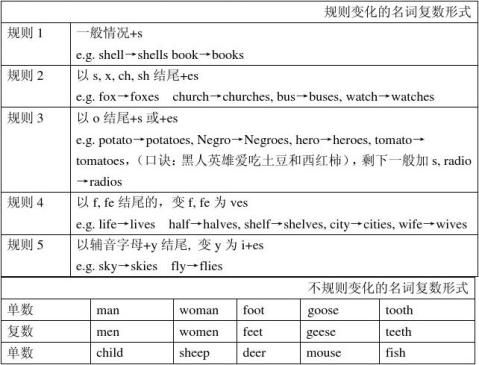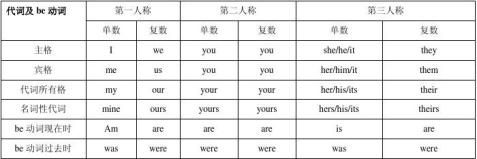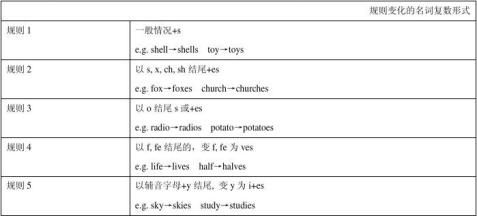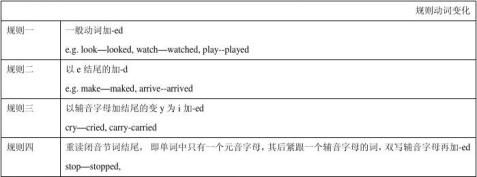一时态: 一般现在时,现在进行时,一般过去时,现在完成时,一般将来时,过去进行时,过去完成时,过去将来时
1. 一般现在时
表示一般性,经常性的动作或一般性事实。
????????含有be动词的句子
He is a teacher.
The girl is very beautiful.
Tim and Jack are students.
★变疑问句将be动词移到句首
Is he a teacher?
Is the girl very beautiful?
Are Tim and Jack students?
★变否定句在be动词后面加not
He is not a teacher.
The girl is not very beautiful.
Tim and Jack are not students.
★肯定回答及否定回答
Yes, he is. No, he is not.
Yes, she is. No, she is not.
Yes, they are. No, they are not.
????????不含有be动词的句子,即含有一般动词的句子
第三人称单数及单数名词 :
He likes books.
She likes him.
The dog likes bones.
★变疑问句在句首加does, 动词变为原型
Does he like books?
Does she like him?
Does the dog like bones?
★变否定句在主语及动词之间加doesn’t, 动词变为原型
He doesn’t like books.
She doesn’t like him.
The dog doesn’t like bones.
★肯定回答及否定回答:
Yes, he does. No, he doesn’t.
Yes, she does. No, she doesn’t
Yes, it does. No, it doesn’t.
注意:第三人称单数形式一般在动词后面加S,不要和名词复数混淆,变否定句或疑问句时名词复数没有任何变化。
其他人称及复数名词
I want to have a bath.
We have some meat.
The students like smart teachers.
★变疑问句在句首加do
Do you want to have a bath?
Do we have any meat?
Do the students like smart teachers?
★变否定句在主语和动词之间加don’t.
You don’t want to have a bath.
We don’t have any meat.
The students don’t like smart teachers.
★肯定回答及否定回答
Yes, I do. No, I don’t.
Yes, we do. No, we don’t
Yes, they do. No, they don’t.
2. 现在进行时
表示现在正在进行的动作。
构成: 主语+be动词+动词的现在分词+其它成分(现在分词的构成见附录)
We are having lunch.
He is reading a book.
The dog is running after a cat.
The boys are swimming across the river.
★变疑问句将be动词移到句首
Are we having lunch?
Is he reading a book?
Is the dog running after a cat?
Are the boys swimming across the river?
★变否定句在be动词后面加 not
We are not having lunch.
He is not reading a book.
The dog is not running after a cat.
The boys are swimming across the river.
★特殊疑问句:what, which, how, where, who, etc.
疑问词+动词+主语+现在分词
What are you doing?
What is she doing?
What is the dog doing?
(必背)
没有进行时的动词
表示状态,思想,感情和感觉的动词不能表示正在进行的动作
1. 表示感觉,感官的词
see, hear, like, love, want,
2. have, has当”拥有”讲时没有进行时
3. 一般过去时
表示过去发生的动作或事件, 常和表示过去的时间状语连用,如yesterday, last night, the day before yesterday, 3 days ago,
含有be动词的句子, 将动词变为过去式,am, is的过去式为was,are的过去式为were
I was at the butcher’s.
You were a student a year ago.
The teacher was very beautiful ten years ago.
★变疑问句将be动词移动到句首
Were you at the butcher’s?
Were you a student a year ago?
Was the teacher very beautiful ten years ago?
★变否定句在be动词后面加not
I was not at the butcher’s.
You were not a student a year ago.
The teacher was not very beautiful ten years ago.
★肯定回答否定回答
Yes, I was. No, I was not.
Yes, you were. No, you were not.
Yes, he/she was. No, he/she was not.
★特殊疑问句:
What did you do?
(必背)
不含有be动词的句子,将动词变为过去式,动词过去式构成见附录 I finished my homework yesterday.
The boy went to a restaurant.
The Sawyers lived at King Streeta year ago.
King Streeta year ago.
★变疑问句在句首加did, 动词变为原型
Did you finish your homework yesterday?
Did the boy go to a restaurant?
Did the Sawyers live at King Streeta year ago?
King Streeta year ago?
★变否定句在主语和动词之间加did not
I did not finish my homework yesterday.
The boy did not go to a restaurant.
The Sawyers did not live at King Streeta year ago.
King Streeta year ago.
★肯定回答及否定回答
Yes, I did. No, I didn’t.
Yes, he did. No, he didn’t.
Yes, they did. No, they did not.
4. 现在完成时
构成:主语+助动词have, has+过去分词
用法:
1) 表示过去发生的和现在有某种联系的动作,常和just, usually, already, since等时间副词连用 I have just had lunch. (饱了,不用再吃了)
He has had a cup of tea.(不渴了,不用再喝)
They have already had their holiday. (不能再度假了)
The boy has already read the book. (已经知道书的内容了,不用再看了) 2) 询问别人是否做过某事一般用现在完成时:
Have you finished your homework?
Have you been to Beijing?
Have he seen the film?
3) 表示开始于过去并持续到现在的动作
I have lived in Beijing for twenty years.
I have worked for this school for 1 year.
4) 表示一种经历,经验:去过…地方,做过…事情,经历过…事情 I have never had a bath.
I have never seen a film.
I have never been to cinema.
I have ever been to Paris.
Have been to表示去过,have gone to 表示去了
I have been to London.(人已经回来)
He has gone to London.(人还在那里)
5) 表示一种结果, 一般不和时间副词联用
I have lost my pen.
I have hurt myself.
He has become a teacher.
She has broken my heart.
句型变化:
★变疑问句将助动词移到句首,变否定句在助动词后面加not.
e.g. Have you lost your pen? I have not lost my pen.
★肯定回答及否定回答
Yes, I have. No, I have not.
★特殊疑问句:
What have you done?
What has he done?
一般过去时与现在完成时的区别:
凡是有明确的表示过去的时间状语的句子为过去时
注意:有些动词表示的动作有一个终点,不能再延续,因此不能和表示一段时间状语连用
错:I’ve left Beijing for 3 days.
对:I left Beijing 3 days ago. I have been away from being for 3 days.
5. 一般将来时
表示将来将要发生的动作, 经常和tomorrow, next year, the day after tomorrow, the year after the next, in five hours’ time, etc. 表示将来的词联用
结构: 主语+助动词will+动词原形
I will go to America tomorrow.
The pilot will fly to Japan the month after the next.
Jack will move into his new house tomorrow morning.
★变疑问句将助动词移到句首
Will you go to America tomorrow?
Will the pilot fly to Japan the month after the next?
Will Jack move into his new house tomorrow morning?
★变否定句在助动词后面加not
I will not go to America tomorrow.
The pilot will not fly to Japan the month after the next.
Jack will not move into his new house tomorrow morning
★肯定回答及否定回答
Yes, I will. No, I will not.
Yes, he/she will. No, he/she will not.
Yes, he will. No, he will not.
★特殊疑问句:
What will you do?
6. 过去完成时:
用法:在过去的时间里,两个动作中,发生在前的哪个动作要用过去完成时。
结构:had+过去分词
After she had finished her homework, she went shopping.
They had sold the car before I asked the price.
The train had left before I arrived at the station.
After/before引导的时间状语从句放在句首要在句子后面加逗号,如果放在主句后则不用加。
★ 变疑问句将助动词移到句首
Had she finished her homework?
★ 变否定句在助动词后面加not
She hadn’t finished her homework.
★ 肯定回答及否定回答
Yes, she had. No, she hadn’t.
★ 特殊疑问句: What had she done?
7. 过去进行时
表示过去正在进行的动作,经常用在when, while, as引导的状语从句中。
结构:was/were+doing
When my husband was going into the dining room this morning, he dropped some coins on the floor. While we were having dinner, my father was watching TV.
8. 过去将来时
结构:would do
She said she would go here the next morning.
一. 特殊句型:there be 句型,be going to 结构
1. Be going to 结构
表示打算,准备,计划做某事
★结构:主语+be动词+going to +动词原型
I am going to make a bookcase.
They are going to paint it.
The father is going to give the bookcase to his daughter.
★变疑问句将be动词移到句首
Are you going to make a bookcase?
Are they going to paint it?
Is the father going to give the bookcase to his daughter?
★变否定句在be动词后面加not
I am not going to make a bookcase.
They are going to paint it.
The father is not going to give the bookcase to his daughter.
★肯定回答及否定回答
Yes, I am. No, I am not.
Yes, they are. No, they are not.
Yes, he is. No, he is not.
★特殊疑问句
What are you going to do?
What are they going to do?
What is the father going to do?
(必背)
2. There be 句型
表示哪里有什么东西(某处有某物)
????????There is+单数名词+表示场所的词(一般为介词词组)
There is a book in this room.
There is a pen on the table
????????There are+复数名词+表示场所的词(一般为介词词组)
There are two pens on the table.
There are three schools there.
★变疑问句将be动词移到句首
Is there a book in this room?
Are there two pens on the table?
★变否定句在动词后面加not
There is not a book in this room.
There are not two pens on the table.
★肯定回答及否定回答
Yes, there is. No, there is not.
Yes, there are. No, there are not.
一. 问句:
一般疑问句,特殊疑问句,选择疑问句,反意疑问句,选择疑问句,否定疑问句 ?????????一般疑问句: 助动词/be动词+主语
Are you a teacher? Do you want to have a cup of tea?
?????????特殊疑问句: 特殊疑问词+一般疑问句
What is your name?
?????????选择疑问句: or
Do you want beef or lamb?
?????????反意疑问句: 肯定陈述句+否定疑问部分, 否定陈述部分+肯定疑问部分
You don’t need that pen, do you?
?????????否定疑问句: 一般疑问句+否定词
Aren’t you lucky? Don’t you want have a rest?
二. 冠词用法:a/an/the的一般用法
详细见笔记
三. 限定词:some, any, many, much
?????????some, any 修饰可数名词或不可数名词,some用于肯定句,any用于否定句和疑问句,注意,当期待
对方的答案为肯定回答时用some
?????????many修饰可数名词,much修饰不可数名词,在口语中表示很多一般不用many, much, 而用a lot of, 在
否定句中表示很多用many, much.
I have a lot of money. I don’t have much money.
四. 名词:种类,复数,名词所有格
1.名词分为可数名词和不可数名词
?????????不可数名词
无法分开的东西:water, tea, bread, milk, rice(米)
抽象的东西:love, beauty, coldness(寒冷)
不可数名词有以下特点:
??????????不能用a, an修饰
??????????不能加s
??????????和单数be动词或动词搭配
?????????可数名词:


六.副词:用法及形容词变副词的变化
????????副词可以修饰形容词,动词,副词或整个句子。如:
The book is very good.
He runs fast.
She came here quite early.
Certainly I will go with you.
????????变化:
1. 直接在形容词后加-ly,
careful-carefully, slow-slowly,
2. 以辅音字母加y结尾的形容词,把y变I, 加-ly,
happy-happily, lucky-luckily
3. 有些词形容词和副词的形式相同,不需要做任何变化
fast, hard, late
4. 有些词加上-ly后意思与原词相差很远:
neary-nearly, high-highly, late-lately,
一. 情态动词的使用:can, must, may, might, need,
1.情态动词can(能够), must(必须), may(可以)
结构:主语+can/must/may+动词原型
He can make the tea.
Sally can air the room.
We can speak English.
★变疑问句将情态动词移到句首
Can he make the tea?
Can Sally air the room?
Can we speak English?
★变否定句在情态动词后面加not
He cannot make the tea.
Sally cannot air the room.
We cannot speak English.
★肯定回答及否定回答
Yes, he can. No, he cannot.
Yes, she can. No, she cannot.
Yes, we can. No, we cannot.
★特殊疑问句:
What can you do?
(必背)
注意:情态动词的句子没有第三人称单数的变化,不要在情态动词或动词后面加S。
2.Must/have to的区别
must 表示必须,是主观上觉得应该做,have to是不得不,是由于客观条件逼迫的必要要做 must 只能用在表示现在和将来的句子里,而have to do可以用在任何时态
3.must, may, might表示猜测:
????????must do 表示对现在事实的猜测
????????must have done表示对过去事实的猜测
????????must have been doing 表示对过去正在进行的事实的猜测
????????may/might do, may/might have done表示没有任何事实依据的猜测,might的可能性更小。 ????????can’t/couldn’t 表示不可能
4.need 用法:
????????表示“需要”时为实意动词,后面可以加名词,也可以加不定式: I need a pen. Do you need any beer? No, I don’t. I need to have a rest.
????????Need doing=need to be done,表示被动 The flowers need watering.
????????Need在否定时做情态动词使用
You needn’t go so early. =You don’t need to go so early. Must I clean the desk right now? No, you needn’t.
一. 不定代词及不定副词:
I looked for my book everywhere, but I can’t find it anywhere.
If you want go somewhere, if you want to be someone, you must wake up. Help! Somebody?
Anybody?
You are really something.
Since everybody is here, let’s begin our class. Where did you go? I went nowhere. Nobody is at home. I have nothing left.
二.感叹句:
????????What +名词+主语+谓语 What a beautiful girl she is!
????????How + 形容词+主语+谓语 How beautiful the girl is!
三. 祈使句:
??????????第二人称:
??????????let+其他人称代词
??????????祈使句的否定,加don’t ??????????反意疑问
祈使句(第二人称)
祈使句表示请求,命令,建议,邀请等,谓语动词一律用原型,句子中通常不用主语,句末用惊叹好或者句号,用降调。 ★肯定句 动词原型
例, Come here, please. Go downstairs, please. Stand up. Sit down. Be quiet. Be careful. 祈使句中如果有唤语,一定要用逗号隔开,放在句首或者句尾 Come in, Amy.
Sit down here, Tom.
Mary, give me a book please. ★否定:Don't+动词原型 Don't come here. Don’t sit down. Don’t stand up. Don’t give me it. let sb. do Let me pass.
Let us have a rest.

Let’s have a rest.
(反意疑问):
Let’s have a walk along the river, shall we?
Let us go out for a drink, will you?
四. 倒装句:so/neither的倒装eg.
He can swim. So can I.
I didn’t go to class. Neither did I.
结构:
so/neither+be+ 主语
so/neither+助动词+ 主语
so/neither+情态动词+ 主语
一般现在时, do, does/am, is, are
现在进行时, am, is, are
一般过去时, did
现在完成时, have, has
一般将来时, will, shall,
过去进行时,was, were
过去完成时,had
过去将来时, would
五. 直接引语/间接引语
如果引语的主句所用动词为过去时,那么间接引语要做相应变化:时态,人称,时间地点及指示词 ????????时态变化:
一般现在时——一般过去时
现在进行时——过去进行时
一般过去时——过去完成时
现在完成时——过去完成时
一般将来时——过去将来时
be going to——was/were going to/would
can----------------could
may---------------might
????????时间地点及指示词的变化:
here—there, tomorrow—the next day, the following day, this—that…
????????人称变化:根据句意改变人称。
六. 直接宾语/间接宾语
主语+及物动词+间接宾语+直接宾语
直接宾语是及物动词的直接对象,间接宾语是及物动词的动作所涉及的人或事务,也可以说间接宾语表示动作是对谁做的,或者是为谁做的。所以间接宾语要用名词或者宾格代词来担当。
He gives me a book.
me间接宾语, a book直接宾语
直接宾语和间接宾语的位置调换时要加一个介词to或for
主语+及物动词+直接宾语+介词+间接宾语
Give me a book.
Give the book to me.
Send his a letter.
Send a letter to him.
Show him the new dress.
Show the new dress to him.
一. 从句:
宾语从句,定语从句(限定性),表语从句,状语从句(if引导的真实条件句)
????????宾语从句:如果宾语从句的主句中的动词为过去时,那么宾语从句中的时态要和主句统一;如果宾语
从句为疑问词引导,那么语序要用陈述语序,即主语在前,动词在后。 ????????定语从句: ????????表语从句:
????????状语从句(if引导的真实条件句):主句用一般将来时,从句用一般现在时 What will you do if you win a lot of money? If it rains tomorrow, I will stay at home.
二. 动词不定式做宾语及宾语补语的用法(详细用法请见NECII)
结构: to do,
用法:可以做除谓语以外的所有成分,语法上称之为非谓语动词。 做宾语:在一些动词后常用不定式做宾语,例如:want, like, ask ,try… 做宾补:want sb. to do, ask sb. to do, like sb. to do… 附录:
代词及be动词
名词复数
动词的第三人称单数形式 动词现在分词 动词过去式 过去式的读音 形容词的比较级

名词的复数
动词的第三人称单数形式



动词现在分词

动词过去式


过去式的读音
形容词和副词的比较级

形容词和副词的最高级

常见缩写:
is=’s I am=I’m are=’re
is not=isn’t/ iznt/ are not=aren’t /a:nt/ do not=don’t
does not=doesn’t
was=’s
did not=didn’t
can not=can’t
have=’ve
has=’s
have not=haven’t
has not=hasn’t
will=’ll
will not=won’t
shall not=shan’t
